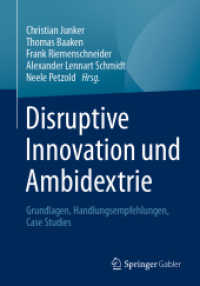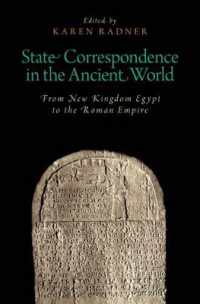Full Description
Grounded in current theory and research, yet practical and teachable.Widely praised for its groundbreaking integration of composition research and a rhetorical perspective, The Allyn & Bacon Guide to Writing with MyWritingLab has set the standard for first-year composition courses in writing, reading, critical thinking, and inquiry.Teachers and students value its clear and coherent explanations, engaging classroom activities, and flexible sequence of aims-based writing assignments that help writers produce effective, idea-rich essays in academic and civic genres. Numerous examples of student and professional writing accompany this thorough guide to the concepts and skills needed for writing, researching, and editing in college and beyond.
Contents
Part 1 A Rhetoric For Writers1 Posing Problems: The Demands of College Writing Why Take a Writing Course? Concept 1.1 Subject matter problems are the heart of college writing. Shared Problems Unite Writers and Readers Where Do Problems Come From? Concept 1.2 Writers' decisions are shaped by purpose, audience, and genre. What Is Rhetoric? How Writers Think about Purpose How Writers Think about Audience How Writers Think about Genre Concept 1.3 The rules for "good writing" vary depending on rhetorical context. A Thought Exercise: Two Pieces of Good Writing That Follow Different "Rules" David Rockwood, A Letter to the Editor Thomas Merton, A Festival of Rain Distinctions between Closed and Open Forms of Writing Flexibility of "Rules" along the Continuum Where to Place Your Writing along the Continuum Chapter Summary BRIEF WRITING PROJECT TWO MESSAGES FOR DIFFERENT PURPOSES, AUDIENCES, AND GENRES 2 Exploring Problems, Making Claims Concept 2.1 To determine their thesis, writers must often "wallow in complexity." Learning to Wallow in Complexity Seeing Each Academic Discipline as a Field of Inquiry and Argument Using Exploratory Writing to Help You Wallow in Complexity Believing and Doubting Paul Theroux's Negative View of Sports Concept 2.2 A strong thesis statement surprises readers with something new or challenging. Trying to Change Your Reader's View of Your Subject Giving Your Thesis Tension through "Surprising Reversal" Concept 2.3 In closed-form prose, a typical introduction starts with the problem, not the thesis. A Typical Introduction Features of an Effective Introduction Chapter Summary BRIEF WRITING PROJECT PLAYING THE BELIEVING AND DOUBTING GAME 3 How Messages Persuade Concept 3.1 Messages persuade through their angle of vision. Recognizing the Angle of Vision in a Text Analyzing Angle of Vision Concept 3.2 Messages persuade through appeals to logos, ethos, and pathos. Concept 3.3 Messages persuade through writers' choices about style and document design. Understanding Factors that Affect Style Making Purposeful Choices about Document Design Concept 3.4 Nonverbal messages persuade through visual strategies that can be analyzed rhetorically. Visual Rhetoric The Rhetoric of Clothing and Other Consumer Items Chapter Summary 4 Multimodal and Online Communication Concept 4.1 Composers of multimodal texts use words, images, and sounds rhetorically to move an audience. Hooking Audiences with Images and "Nutshell" Text Holding Readers through Strong Content Designing Video Narratives that Move Viewers Concept 4.2 Online environments are rhetorically interactive with shifting audiences, purposes, genres, and authorial roles. Shifting and Evolving Rhetorical Contexts Online Online Variations in Purposes, Genres, and Authorial Roles Maintaining Appropriate Online Privacy Concept 4.3 Responsible participation in online discourse requires understanding intellectual property rights and an ethical persona. Understanding Issues of Copyright, Fair Use, and Creative Commons Licenses Using Images and Sound Ethically in Your Multimodal Projects Creating an Ethical Online Persona Chapter Summary CREATION OF A MULTIMODAL COMPOSITIONPart 2 Writing ProjectsWriting To LEARN5 Reading Rhetorically: The Writer As Strong Reader 82Engaging Rhetorical Reading Understanding Rhetorical Reading What Makes College-Level Reading Difficult? Using the Reading Strategies of Experts Reading with the Grain and Against the Grain Understanding Summary Writing Usefulness of Summaries The Demands that Summary Writing Makes on Writers Summary of "Why Bother?" Understanding Strong Response Writing Strong Response as Rhetorical Critique Strong Response as Ideas Critique Strong Response as Reflection Strong Response as a Blend Kyle Madsen (student), Can a Green Thumb Save the Planet? A Response to Michael Pollan WRITING PROJECT A SUMMARY Generating Ideas: Reading for Structure and Content Drafting and Revising Questions for Peer Review WRITING PROJECT A SUMMARY/STRONG RESPONSE ESSAY Exploring Ideas for Your Strong Response Writing a Thesis for a Strong Response Essay Shaping and Drafting Revising Questions for Peer Review Michael Pollan, Why Bother? Writing To EXPLORE6 Writing An Exploratory Essay or Annotated BibliographyEngaging Exploratory Writing Understanding Exploratory Writing Generating and Exploring Ideas Taking "Double-Entry" Research Notes Shaping and Drafting Revising Questions for Peer Review Bibliography? Features of Annotated Bibliography Entries Examples of Annotation Entries Writing a Critical Preface for Your Annotated Bibliography Shaping, Drafting, and Revising Questions for Peer Review ReadingsKent Ansen (student), Should the United States Establish Mandatory Public Service for Young Adults? Kent Ansen (student), Should the United States Establish Mandatory Public Service for Young Adults? An Annotated Bibliography Writing To Analyze and Synthesize7 Analyzing Images Engaging Image Analysis Understanding Image Analysis: Documentary and News Photographs Angle of Vision and Credibility of Photographs How to Analyze a Documentary Photograph Sample Analysis of a Documentary Photograph Understanding Image Analysis: Paintings How to Analyze a Painting Sample Analysis of a Painting Understanding Image Analysis: Advertisements How Advertisers Think about Advertising Mirrors and Windows: The Strategy of an Effective Advertisement How to Analyze an Advertisement Sample Analysis of an Advertisement Exploring and Generating Ideas for Your Analysis Shaping and Drafting Your Analysis Revising Questions for Peer Review ReadingLydia Wheeler (student), Two Photographs Capture Women's Economic Misery8 Analyzing and Synthesizing Ideas Engaging Analysis and Synthesis John Miley, Ground Rules for Boomerang Kids Publishers Weekly, Review of The Accordion Family: Boomerang Kids, Anxious Parents, and the Private Toll of Global Competition Understanding Analysis and Synthesis Posing a Significant Synthesis Question Synthesis Writing as an Extension of Summary/Strong Response Writing WRITING PROJECT A SYNTHESIS ESSAY Summarizing Your Texts to Explore Their Ideas Rosie Evans (student), Summary of Robin Marantz Henig's ArticleRosie Evans (student), Summary of Scammed Hard!'s Blog Post Analyzing Your Texts Rosie Evans (student), Rhetorical Analysis of Henig's Article Rosie Evans (student), Rhetorical Analysis of Scammed Hard!'s Blog Post Analyzing the Main Themes and Similarities and Differences in Your Texts' Ideas Synthesizing Ideas from Your Texts Rosie Evans (student) Exploration of Her Personal Connections to Her Texts and the Synthesis Question Taking Your Position in the Conversation: Your Synthesis Shaping and Drafting Writing a Thesis for a Synthesis Essay Organizing a Synthesis Essay Revising Questions for Peer Review Rosie Evans (student), Boomerang Kids: What Are the Causes of Generation Y's Growing Pains? 9 Writing A Classical Argument Engaging Classical Argument Understanding Classical Argument What Is Argument? Stages of Development: Your Growth as an Arguer Creating an Argument Frame: A Claim with Reasons Articulating Reasons Articulating Underlying Assumptions Using Evidence Effectively Evaluating Evidence: The STAR Criteria Addressing Objections and Counterarguments Responding to Objections, Counterarguments, and Alternative Views Seeking Audience-Based Reasons Appealing to Ethos and Pathos A Brief Primer on Informal Fallacies WRITING PROJECT A CLASSICAL ARGUMENT Generating and Exploring Ideas Shaping and Drafting Questions for Peer Review BUMPER STICKER ReadingsRoss Taylor (student), Paintball Claire Giordano (student), Virtual Promise: Why Online Courses Will Not Adequately Prepare Us for the Future (APA format research paper) 10 Proposing A Solution Engaging Proposal Writing Understanding Proposal Writing Special Challenges of Proposal Arguments Developing an Effective Justification Section Multimodal Proposal Arguments WRITING PROJECT A PROPOSAL ARGUMENT Generating and Exploring Ideas Shaping and Drafting Revising Questions for Peer Review SPEECH WITH VISUAL AIDS ReadingsLucy Morsen (student), A Proposal to Improve the Campus Learning Environment by Banning Laptops and Cell Phones from Class Sam Rothchild (student), Reward Work Not Wealth (oral presentation with visual aids) Kent Ansen (student), Engaging Young Adults to Meet America's Challenges: A Proposal for Mandatory National Service (MLA format research paper)Part 3 A Guide To Composing and Revising11 Writing As A Problem-Solving Process SKILL 11.1 F ollow the experts' practice of using multiple drafts. Why Expert Writers Revise So Extensively An Expert's Writing Processes Are Recursive SKILL 11.2 R evise globally as well as locally. SKILL 11.3 D evelop ten expert habits to improve your writing processes. SKILL 11.4 Use peer reviews to help you think like an expert. Becoming a Helpful Reader of Classmates' Drafts Using a Generic Peer Review Guide Participating in Peer Review Workshops Responding to Peer Reviews 12 Strategies For Writing Closed-Form Prose SKILL 12.1 Satisfy reader expectations by linking new material to old material. The Principle of Old before New How the Principle of Old Before New Creates Unified and Coherent Paragraphs The Explanatory Power of the Principle of Old before New SKILL 12.2 N utshell your argument and visualize its structure. Make a List of "Chunks" and a Scratch Outline Early in the Writing Process To Achieve Focus, "Nutshell" Your Argument and Create a Working Thesis Statement Visualizing Your Structure SKILL 12.3 Start and end with the "big picture" through effective titles, introductions, and conclusions. What Not to Do: "Topic Title" and the "Funnel Introduction" Creating Effective Titles Writing Good Closed-Form Introductions Writing Effective Conclusions SKILL 12.4 Create effective topic sentences for paragraphs. Placing Topic Sentences at the Beginning of Paragraphs Revising Paragraphs for Unity Adding Particulars to Support Points SKILL 12.5 G uide your reader with transitions and other signposts. Using Common Transition Words to Signal Relationships Writing Major Transitions between Parts Signaling Major Transitions with Headings SKILL 12.6 Bind sentences together by placing old information before new information. The Old/New Contract in Sentences How to Make Links to the "Old" Avoiding Ambiguous Use of "This" to Fulfill the Old/New Contract SKILL 12.7 Use effective tables, graphs, and charts to present numeric data. How Tables Tell Many Stories Using a Graphic to Tell a Story Incorporating a Graphic into Your Essay 13 Strategies For Composing Multimodal Texts SKILL 13.1 Consider a range of multimodal options for accomplishing your purpose. SKILL 13.2 D esign multimodal texts so that each mode contributes its own strengths to the message. This Design Principle at Work In Successful Multimodal Texts Using This Design Principle to Revise a Jumbled Multimodal Text SKILL 13.3 D esign multimodal genres including posters, speeches with visual aids, podcasts, and videos. Informational or Advocacy Posters, Brochures, Flyers, and Ads Speeches with Visual Aids (PowerPoint, Prezi, Pechakucha) Scripted Speech (Podcasts, Video Voiceovers) Videos Part 4 A Rhetorical Guide To Research14 Using Sources SKILL 14.1 E valuate sources for reliability, credibility, angle of vision, and degree of advocacy. Reliability Credibility Angle of Vision and Political Stance Degree of Advocacy Criteria for Evaluating a Web Source SKILL 14.2 Know when and how to use summary, paraphrase, and quotation. Summarizing Paraphrasing Quoting SKILL 14.3 Use attributive tags to distinguish your ideas from a source's. Attributive Tags Mark Where Source Material Starts and Ends Attributive Tags Avoid Ambiguities that Can Arise with Parenthetical Citations Attributive Tags Frame the Source Material Rhetorically SKILL 14.4 Avoid plagiarism by following academic conventions for ethical use of sources. Why Some Kinds of Plagiarism May Occur Unwittingly Strategies for Avoiding Plagiarism 15 Citing and Documenting Sources SKILL 15.1 Cite and document sources using MLA style. In-Text Citations in MLA Style Works Cited List in MLA Style MLA Citation Models MLA Format Research Paper SKILL 15.2 Cite and document sources using APA style. In-Text Citations in APA Style References List in APA Style APA Citation Models








